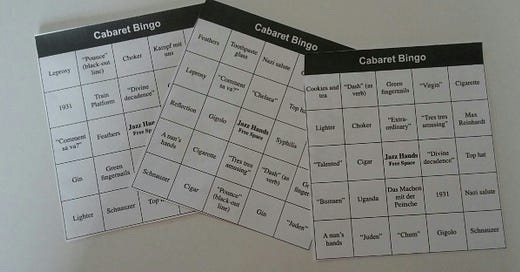Every few weeks the Bad Dream Factory workshop gets a movie night. To date these take place in Chelsea Cain’s huge theater1 room. We eat pizza. Our dogs sleep and play around us. We’ve watched The Hunger to study how it uses gestures to bridge between one shot and the next. This week we’ll watch Cabaret and play – wait for it – Cabaret Bingo. Chelsea has software that makes bingo cards, of course she does, and I’ve made a list of the repeating elements to look for.
Certain films stay in my life so I can study how they work. Films like Session 9, with very limited settings, limited characters and small, defined windows of time. Cabaret ticks all those boxes. Among the elements we’ll be looking for are:
Train stations. The narrative story-line begins and ends on a platform in the Berlin station. And trains in general when you consider how a train whistle covers the “primal screaming” scene. Also note how the screaming of the can-can dancers echoes the primal screaming below the train tracks, and this also implies the pain of the abortion — building on innocuous elements introduced in earlier, happier parts of the story.
Sally’s fingernails, green or unpainted. And the jazz hands gesture used four times, with or without the catch phrase “Divine Decadence.” In each case the signature gesture becomes more grave until it becomes the good-bye wave of a woman about to be destroyed in Nazi Germany. These quick occurrences are good for five squares on the bingo card.
Another repeated element is the cigar. First, it’s a gift from a pornographer – “The finest Havana”. Later, it reappears to celebrate the impending birth of a baby. Another two squares on the card.
Along the same lines, Das Machen mit der Peitsche is the title of the pornographic novel to be translated. And it’s the scene acted out in silhouette on stage at the nightclub.
Leprosy is named as a threat in the line, “Sincerely hope nose doesn’t fall off.” And syphilis is the other disease mentioned, hinting at more lost noses.
Next, look out for the gold cigarette case. First, it’s rejected. Then it falls out of a man’s pants. Finally, it reappears with a third meaning. Catch all the iterations, and you’ll fill three squares.
Cookies, two squares.
The trope of a dead dog. One square.
Cross dressing, at least two squares. More if you consider the larger theme of Jews posing as gentiles, men dressed as gorillas, poor people acting rich.
The fur coat. At least three squares.
Let’s not forget the child’s red ball that bounces down the stairs at the abortionist’s. And how it echoes the red “ball” that Sally stands inside as the spotlight outlines her against the red stage curtain on the movie poster and in the nightclub scenes.
An endless number of bingo card squares can be devoted to black-out gestures or black-out lines. The former are scenes that end in a physical action. The latter end in a line of dialog. If memory serves, most scenes in the film end with gestures, no doubt due to Bob Fosse the director also being a choreographer. The one scene I recall that ends with dialog ends with characters trading the verb “pounce” back and forth.
The point is to make students aware of the objects and themes in play. And to stress limiting such objects so that they accrue a deeper meaning each time they reappear.
Don’t get me started on Rosemary’s Baby Bingo. It has so many ambiguous doorbells. Two missing brothers. Two gay guy couples. Two obstetricians. Two female characters who look like “real” actors: Rosemary is said to look like Piper Laurie, Terry Gionoffrio is mistaken for Anna Maria Alberghetti. Many reappearances of the same necklace. Two books: one self-help, one about witchcraft. Three dreams. Two satanic curses: blindness and death — three if you consider Mrs. Gardenia dying offstage. Two personal possessions stolen. Guy Woodhouse has played in two Broadway shows. The movie and book are nothing but repeating patterns. They are magnificent, but they are a game for another movie night.
A confession and a debate. Despite having seen this film roughly a hundred zillion times, seeing it with Chelsea was a revelation. In particular the scene where the German gigolo confides that he’s Jewish. For the first time I wondered, “How can you have sex for a living and hide the fact you’re circumcised?” In Wiemar Germany this seems like an especially touchy detail. The film “Europa Europa” revolves around Solomon Perel needing to hide his penis from the Nazis constantly. Chelsea says that in 1972, when “Cabaret” was released, no one would consider the detail of circumcision. It simply was not discussed. What do you think? Plot hole or not?
Yeah, sorry to spoil the plot, but that’s the name of this newsletter, no?








Hi Chuck, you say that you're like a gallery owner because your job is to steal ideas from others (you said that), well could you please steal from me? I have a few Chuck Palahniuk-ideas I just don't know what to do with them. What should I do?
Yet again, I’m blown away by the collective unconscious (the two faced friend of every creative artist - in this case best friend). Every year I watch ‘Cabaret’ and ‘All That Jazz’ as a double feature and then throw ‘Lenny’ into the mix if I want to continue the sneaking-in -to-another/theater-without-paying-on-the-same-day vibe. ‘Star 80’ and ‘Sweet Charity’ are solo artists playing their own individual gigs. Last Saturday, I made the trip (albeit into the Living Room) back to school (as I refer to it) for the triple feature. Along with Hal Ashby, Fosse is not mentioned enough or even just higher atop the lists of enough people who consider themselves to be die hard cinephiles or even just fans of films. ‘All That Jazz’ is like a Bible to me. It’s a holy book that also happens to be the King of the Land of Metaphors while I can say the same of ‘Cabaret’ as the Queen of a neighboring civilization. I’ve always seen ‘Lenny’ as more of a Duke who happens to be the fun guy at the dinner party. While there’s nothing I can add that you haven’t already mentioned, I never fail to shoot my hand in the air at any chance to mention my love of Fosse’s film work. All of that said, the Bingo angle is new to me and I never discount new experiences. I’ll get out my ruler and some printer paper asap. I have a box of old-school perforated printer paper that’s been screaming out for some attention for at least 35 years.